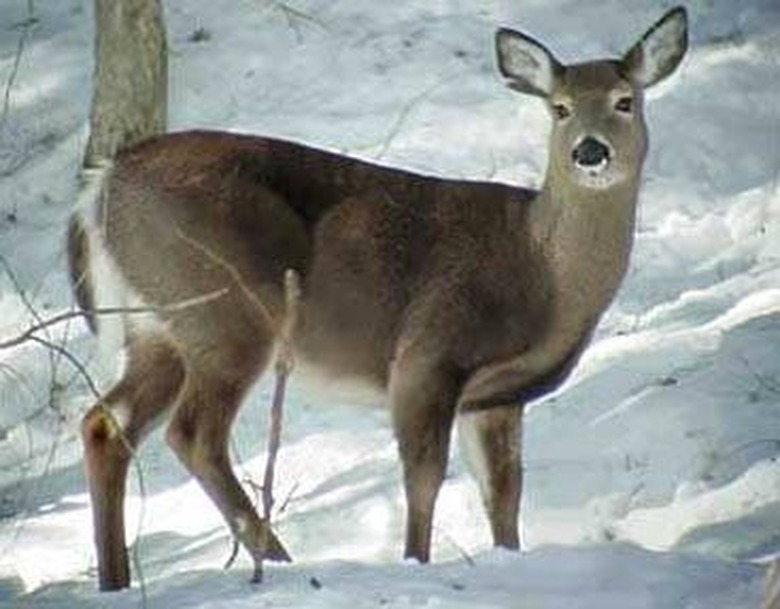How Does A Deer Find Food?
Ruminants
Ruminants
Deer are what are known as ruminants. They have a four-chambered stomach that allows them to eat large amounts of food at any one time. They will chew their food only enough so that it can be swallowed, then regurgitate later in the day or the evening hours and chew it again as cud before swallowing and digesting it. Deer will browse for food in the early morning and evening hours, seeking their primary food source, which is a combination of twigs, leaves, shoots, nuts, berries and flowering plants. Deer have little trouble finding these in abundance in their habitat during the spring, summer and fall. They will seek out newly cut areas, such as around power lines and along the edges of fields, knowing that new saplings often grow there.
Whitetail Deer
Whitetail Deer
Whitetail deer will focus on their preferred foods and make every effort to find them before having to turn to foods they dislike. In the spring, summer and autumn months, whitetail deer will graze on the leaves of hardwood trees like maples, alders, willows, sumac and ash. They will eat the newly formed growth on evergreen trees, and are fond of eating the tops of trees that have recently fallen over. They have a wide selection of food in the spring, as new growth emerges during April and May. In the summer, whitetail deer will gladly eat grasses they find in fields and in woodland meadows, as well as some crops. But they make twigs and leaves a huge part of their diet during these months. As the fall approaches, deer will tend to not like leaves as much: As they change colors and lose chlorophyll, they do not taste as good. Deer will eat nuts during the autumn, with acorns that fall from oak trees, providing them with food. They will simply walk through the forest, looking for and consuming acorns, with those from white oak among their favorites. In the winter, deer will often have to forage for twigs and bark in the heavy snow in the northern states of the U.S. They will scrape away the snow and ice with their hooves and eat whatever vegetable matter that they can uncover. The winter months are the toughest on deer, with mortality rates dependent on the severity of the weather. Deer derive energy from stored fat during the winter; they eat as much as they can in the late fall and require about 50 percent less food in the cold months.
Mule Deer
Mule Deer
Mule deer live in the western portion of the U.S., and are larger than whitetail deer. They eat a variety of things, much as their cousins do. Mule deer will find green leaves and weeds to eat in the warm months, with grasses a larger part of their diet than in that of the whitetail. Mule deer have also been known to consume mushrooms, blackberry and raspberry plants, along with berries and grapes. They can eat the fruit of cactuses in the deserts they inhabit in the Southwest. In the fall and winter, they will browse on coniferous evergreen twigs from trees like the cedar, Douglas fir and juniper. They can easily reach the lower branches of trees for this purpose. Apples and acorns that fall off trees are eaten as well. Mule deer will normally try to find their food where forests begin to meet open grasslands. They do not stray far from a source of water, either. In the winter, they will be forced to forage in the snow as the whitetail deer must, eating whatever they can find when the snow begins to pile up.
Cite This Article
MLA
Lindell, John. "How Does A Deer Find Food?" sciencing.com, https://www.sciencing.com/deer-food-4740696/. 22 November 2019.
APA
Lindell, John. (2019, November 22). How Does A Deer Find Food?. sciencing.com. Retrieved from https://www.sciencing.com/deer-food-4740696/
Chicago
Lindell, John. How Does A Deer Find Food? last modified March 24, 2022. https://www.sciencing.com/deer-food-4740696/

